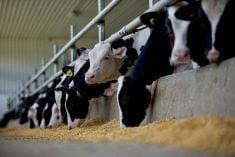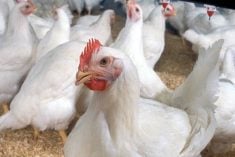(Reuters) — Animal nutritionist John Goihl knows Minnesota farmers who feed the remains of dead baby pigs to hogs used for breeding in attempts to ward off infections of a deadly virus in offspring.
In Oklahoma, farm workers are mixing manure from hogs sick with porcine epidemic diarrhea virus into the food of healthy animals to build their immunity.
In Kansas, farmers are spraying a mixture of hog manure containing the virus and water on the noses of pigs to create a “natural vaccine.”
Across the farm belt, U.S. pork producers are doing whatever they can to shore up their herds’ defences against the virus, which killed up to eight million pigs, a tenth of the nation’s herd, two years ago.
Read Also

Rules-based trading system at risk of derailment, says UN chief
The head of the United Nations said on Wednesday that the global trade system was facing major challenges due to tariffs, with developing countries worst affected.
Farmers fear the disease could return this winter.
The virus, which causes severe diarrhea that kills baby pigs, thrives in cold weather, and declining immunity in the U.S. herd has raised the risk of another outbreak to the highest level since 2013, veterinarians said.
Farmers are better prepared to fight the disease than they were two years ago after implementing procedures to prevent the spread of the virus via farm vehicles, workers’ shoes and animal feed.
Veterinarians said attempts to deliberately expose hogs to the virus also help reduce the risk of an outbreak as big as the one that began in 2013, although it is not clear how many farmers are taking such precautions.
Michael Blackwell, chief veterinarian officer for the Humane Society of the United States, said feeding baby pigs to other hogs “seems to be pretty barbaric,” but he understands why farmers are doing it.
“It is not as inhumane as having millions of piglets killed in an outbreak,” he said.
Veterinarians said commercial vaccines available from Zoetis Inc. and Harrisvaccines offer limited help preventing outbreaks. They do not specifically target the gut and are mainly effective on hogs that have already been exposed to the virus.
Harrisvaccines said vaccines are not a “silver bullet,” and Zoetis said there was not enough data that prove vaccines effectively protect herds that have not previously been infected.
Such limitations, along with concerns that immunity levels have waned, have prompted farmers to adopt methods such as “feedback,” where intestines of piglets killed by the virus are fed to female pigs used for breeding.
Immunity has declined because a growing number of hogs have never been infected, which means they lack the natural immunity that they could pass to their babies, veterinarians say. As well, immunity wears off over time in hogs that were previously infected.
Feedback allows female hogs to become infected and pass on immunity to piglets, which are more likely to die from the disease than older hogs. Those fed infected food or otherwise exposed to the virus usually become sick for a few days but then get well again.
Purposefully exposing hogs to the virus is “really important because that’s one way we can have local establishment and local building of immunity,” said Lisa Becton, the National Pork Board’s director of swine health information and research.
Matt Ackerman, a prominent hog veterinarian in Indiana, estimated that more than a million pigs could die between June 1, 2015, and May 31, 2016, because of a return of the virus, which is much lower than the 2013 levels.
Such losses would occur if 10 percent of sow farms become infected, which Ackerman said was a “very real expectation” that would be devastating to producers.
Two percent of herds cumulatively reported new infections from July 1 to Dec. 4, according to an analysis from Bob Morrison, a professor at the University of Minnesota. That is down from 56 percent between July 2013 and June 2014 and nine percent a year later.
Farmers who want to deliberately expose their herds to the virus should identify infected hogs so they can serve as “vaccine” donors.
Workers at Prestige Farms in Oklahoma place pieces of rope in pens for hogs to bite. The rope is then tested for the virus, said Ron Prestage, who runs a division of the family-owned company.
If the disease is detected, workers scoop up manure from the pens to mix with feed for female breeding hogs so that they can pass on antibodies to piglets through their milk, said Prestage, who is also president of the National Pork Producers Council.
“They get a little bit of a belly ache and have diarrhea and then get over it,” he said.














